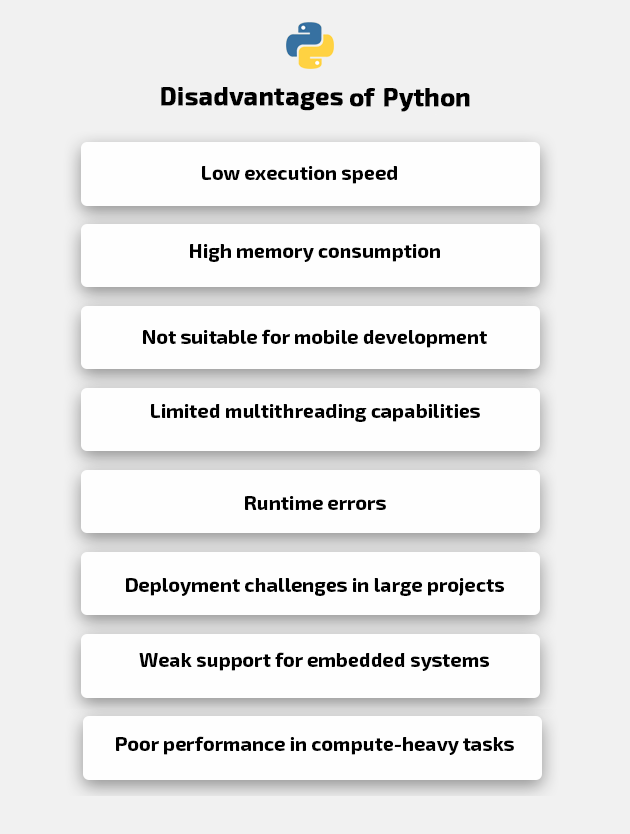Table of Contents
Python is often seen as the perfect starting point in IT. It’s simple, intuitive, and logical—making it the top choice for beginners. But like any tool, it comes with both strengths and limitations that should be understood from the beginning. Knowing the language’s weaknesses is essential for conscious growth in programming. It’s not enough to just know how to use a technology—you also need to understand its boundaries.
Popularity and ease of use can be deceiving—Python is not ideal for every task. It performs poorly in high-load systems, mobile development, and compute-heavy scenarios requiring maximum performance. Despite a rich ecosystem and active community, some technical limitations remain unresolved. Python’s development is evolutionary rather than revolutionary, which keeps it convenient but not universally applicable.
What are the Disadvantages of Using Python?

Despite its strengths, Python has several disadvantages that learners should consider early on. It lags behind other languages in execution speed, especially in resource-intensive tasks. It’s not suitable for all types of development: system software, mobile apps, and games are rarely built with it. Its strict dynamic typing increases runtime error risks. It consumes more memory than average. Additionally, it’s not the best choice for real-time applications or projects requiring massive scalability.
Key disadvantages:
- Low execution speed. Python code is interpreted, not compiled, making it slower than Java, C++, or Go.
- High memory consumption. Large data processing may lead to performance issues and memory overload.
- Not suitable for mobile development. Lacks stable tools for creating modern mobile apps.
- Limited multithreading capabilities. The Global Interpreter Lock (GIL) restricts full parallel processing.
- Runtime errors. Dynamic typing increases the likelihood of subtle bugs only caught at runtime.
- Deployment challenges in large projects. Dependency management and environment configuration can complicate deployment.
- Weak support for embedded systems. Too resource-heavy for microcontroller-level development.
- Poor performance in compute-heavy tasks. Compiled languages are better suited for intensive math operations.
What is the Python Problem?
The “Python problem” usually refers to a combination of limitations that impact its use in production. The main concern is poor performance. Unlike compiled languages, Python is interpreted, which slows execution—especially problematic for real-time processing or handling large data volumes.
Another major issue is the Global Interpreter Lock (GIL), which prevents true multithreading. While Python supports async programming and multiprocessing, classic parallelism remains constrained. Additionally, mobile development integration is weak—tools for Android and iOS are either immature or unstable. Portability across environments also demands precise configuration.
Other challenges include implicit errors. Due to its flexible typing, bugs often appear only at runtime, complicating debugging. Lastly, Python is unsuitable for system software or driver development—those domains remain virtually untouched by the language.
| Problem | Limitation |
|---|---|
| Low execution speed | Interpreted code slows down performance |
| GIL bottleneck | Limits multithreading |
| High memory usage | Inefficient resource utilization |
| Runtime errors | Weak type checking at compile time |
| Complex deployment | Many dependencies and conflicts |
| Weak mobile development support | Lack of stable solutions for iOS and Android |
| Poor game performance | Not suited for complex graphics and physics |
| Limited embedded development | Too resource-intensive for microcontrollers |
FAQ
What is Python disadvantages over Java?
Java outperforms Python in terms of performance and scalability. It is a strictly typed, compiled language, making it better suited for high-load and multithreaded applications without GIL constraints. Java is also more stable in enterprise and banking systems, and has mature support for mobile development via the Android SDK—something Python lacks. Java’s stronger type system also helps reduce logical errors. While Python is easier to learn, Java is better for serious, industrial-scale development.
What are some of the disadvantages of Python?
Python's biggest drawbacks include slow execution and high memory usage. Its programs often run slower, especially with complex logic or large datasets. The GIL makes true multithreading difficult, creating issues for scaling and performance. Python also lacks robust mobile development tools. And with many dependencies, deployment can become unstable and complex. These challenges make it essential to evaluate carefully before using Python for large-scale projects.
What is the biggest problem with Python?
The most critical technical issue is the Global Interpreter Lock (GIL). This architecture prevents concurrent threads from running in parallel, reducing efficiency on multicore processors. Even well-written programs can’t fully utilize CPU resources. This is a major limitation in real-time data processing scenarios. While some workarounds exist, the issue remains unresolved at the core of Python’s architecture, hindering its use in highly parallel systems.
What are the risks of Python?
The main risks are related to scalability and stability. Moving from a prototype to production can expose problems like dependency management, execution unpredictability, and high resource consumption. The lack of a strict type system increases the chance of runtime bugs. In large-scale projects, this can lead to hard-to-trace issues. Without strong compile-time checks, code becomes harder to maintain and secure. That’s why rigorous testing and clean code are essential.
What makes Python slow?
The key reason is that Python is interpreted rather than compiled. Unlike C++ or Rust, which convert code into machine language ahead of time, Python reads and executes code line by line via the interpreter—slowing performance. Its high-level abstractions and automatic memory management also contribute to slowness. Data structures like lists and dictionaries are flexible but resource-heavy. With large-scale operations, this becomes a bottleneck. In real-world applications, heavy components often need to be rewritten in C or optimized using JIT compilers like PyPy.

